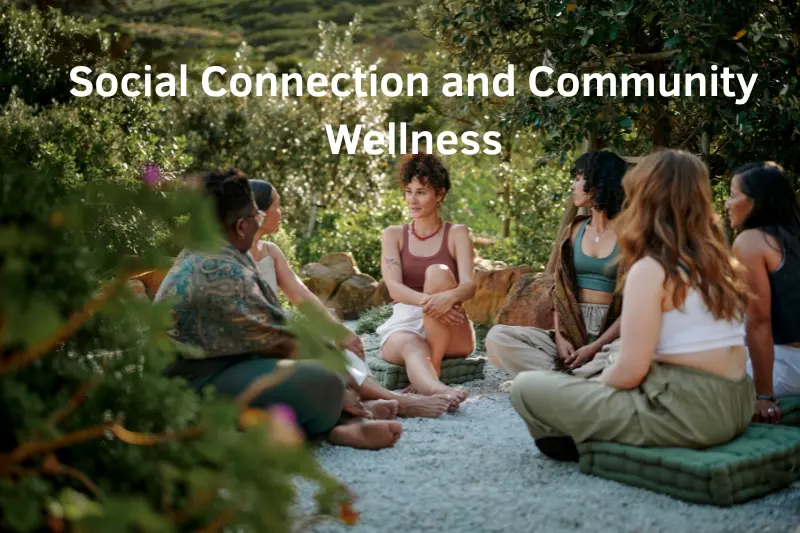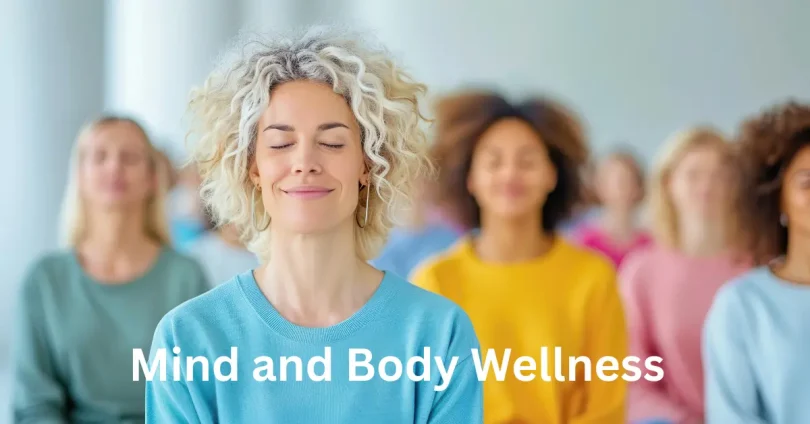Finding a true sense of balance in today’s chaotic world can feel like chasing a moving target. Between career pressures, family obligations, endless notifications, and global uncertainties, it’s easy to feel disconnected—from ourselves, from our purpose, and from our health. But what if you could cultivate a deeper connection between your thoughts, emotions, and physical well-being? That’s the power of Mind and Body Wellness.
This concept goes beyond just physical fitness or mental clarity. It’s a lifestyle approach that integrates emotional balance, physical vitality, mindfulness, and overall inner peace. In this guide, we’ll dive deep into the essential components of Mind and Body Wellness, explore how to incorporate them into your daily life, and share the latest strategies for achieving harmony in every area of your existence. We’ll also break down the newest developments in wellness science and technology, emotional self-care, nutrition, and practical steps you can take to make meaningful changes, no matter your current lifestyle or challenges.
Understanding Mind and Body Wellness
What Is Mind and Body Wellness?

- It refers to a holistic state where mental health and physical health are equally prioritized and interconnected.
- This philosophy combines elements of psychology, nutrition, fitness, and spirituality to create a unified approach to well-being.
- When both mind and body are in sync, people experience enhanced mood, better sleep, reduced stress, and improved overall health.
- It encourages self-reflection, intentional living, and a greater awareness of how daily choices impact long-term health.
The Pillars of Mind and Body Wellness
- Emotional Resilience: Building the mental strength to adapt to adversity and manage stress effectively.
- Physical Vitality: Maintaining a strong, energized body through consistent movement and nourishing foods.
- Spiritual Alignment: Developing practices like meditation, journaling, or breathwork to feel connected to something greater.
- Social Connection: Cultivating meaningful relationships and a sense of community.
- Environmental Support: Creating living and working spaces that foster clarity, calm, and motivation.
Latest Approaches to Mental Wellness
The Rise of Digital Mental Health Tools
- AI-driven therapy apps now offer personalized cognitive behavioral therapy (CBT) sessions.
- Mood tracking tools are being integrated into smartwatches to monitor emotional patterns in real time.
- VR meditation platforms are transforming how people experience mindfulness by offering immersive experiences that help reduce anxiety and promote calm.
- New platforms include gamified journaling and support group chats led by licensed professionals to enhance accessibility.
Neuroplasticity and Brain Training
- Scientific studies show that the brain can rewire itself through deliberate practices like gratitude journaling, puzzle-solving, and consistent learning.
- Brain training apps and games now support memory, focus, and emotional regulation.
- Cognitive fitness is becoming as important as physical fitness in mental wellness routines.
- Practices like dual n-back training and biofeedback meditation are enhancing emotional regulation and attention span.
Mindfulness-Based Stress Reduction (MBSR)
- MBSR programs are gaining momentum in corporate wellness plans.
- These involve structured mindfulness meditation sessions that have shown measurable results in lowering cortisol levels and improving sleep quality.
- Participants also report better interpersonal communication, heightened awareness, and a reduced reactivity to stressors.
- Extended programs now integrate yoga, mindful eating, and digital detox plans.
Latest Physical Wellness Trends
Integrative Fitness Routines
- New fitness approaches combine cardio, resistance, and breath control into a single workout.
- Yoga-Strength Fusion: Combines flexibility and mindfulness with weight training.
- Functional Movement Training: Focuses on enhancing everyday motion patterns to prevent injuries and improve mobility.
- Biohacking Workouts: Use wearable tech and metrics to tailor every session for energy optimization.
- High-intensity micro workouts are also rising for busy individuals who want maximum benefit in minimal time.
Nutrition as Medicine
- Nutritional psychiatry is now exploring how gut health directly impacts mental health.
- The rise of adaptogenic foods (like ashwagandha, turmeric, and maca) supports both cognitive clarity and physical stamina.
- Plant-based and anti-inflammatory diets are showing promising results in reducing chronic illness symptoms and promoting better mood stability.
- Personalized nutrition plans based on genetic testing and microbiome analysis are helping individuals craft tailored eating habits.
Sleep Optimization
- Tech-integrated sleep tools like weighted blankets, sleep rings, and blue-light blocking devices are making restful nights more attainable.
- Experts now suggest syncing sleep cycles with circadian rhythms through light therapy and consistent bedtime routines.
- Smart mattresses and sleep coaching apps are using data analytics to promote deeper, more restorative sleep.
- Sleep hygiene is being recognized as foundational to every other aspect of wellness.
Emotional and Spiritual Wellness Updates
Healing Through Somatic Practices
- Somatic experiencing therapy is growing in popularity, focusing on body-centered techniques to release trauma.
- Practices such as TRE (Tension & Trauma Releasing Exercises) help release deep muscular patterns of stress and trauma.
- Movement-based therapies like ecstatic dance and qigong are being used for emotional healing.
- Therapists now combine body scanning with narrative storytelling to process emotions more effectively.
Breathwork and Emotional Release
- Breathwork sessions are being offered in wellness retreats worldwide to access deep emotional release and clarity.
- Different methods like box breathing, holotropic breathing, and conscious connected breathing are being used to manage anxiety and improve focus.
- Regular breathwork improves heart rate variability, lung capacity, and emotional regulation.
- Pairing breathwork with sound healing and aromatherapy amplifies the healing process.
One read, and you’ll see things differently!
Transform Life with Natural Health and Wellness Solutions
Healthy Living and Wellness: Your Ultimate Guide to Vitality
Transform Your Life with Daily Wellness Habits Today
The Power of Journaling and Reflection
- Structured journaling prompts based on gratitude, intention-setting, and emotional exploration are becoming key tools for clarity.
- Many wellness experts now advocate for combining journaling with visualization techniques for manifestation and self-awareness.
- Bullet journaling, emotion mapping, and mood boards are being embraced for tracking emotional cycles.
- Digital platforms now offer AI-powered journaling with mood-based reflections and goal tracking.
Social Connection and Community Wellness

The Impact of Positive Relationships
- Strong social connections reduce the risk of depression, increase longevity, and boost immunity.
- Group activities like fitness classes, book clubs, and wellness circles are fostering deeper community ties.
- Digital platforms with shared goals (like mindfulness challenges or health missions) create accountability and motivation.
- Relationship wellness coaching is emerging to help people develop better communication and empathy skills.
Digital Detox and Real-Life Engagement
- Conscious use of social media and planned digital detox days help reduce mental overload.
- Community-driven apps and in-person gatherings are gaining traction as people seek real, meaningful conversations.
- Minimalist phone apps are now trending to reduce distractions.
- Time tracking and intentional screen use have been linked to higher productivity and lower anxiety levels.
Volunteering as a Wellness Tool
- Giving back activates the brain’s reward systems, creating feelings of joy and purpose.
- Regular volunteering is linked to decreased depression and greater life satisfaction.
- Corporate volunteering programs and social impact initiatives are on the rise.
- Peer-support models are being built into community wellness centers for ongoing connection.
How to Build Your Personal Mind and Body Wellness Routine
Create a Morning Ritual
- Start your day with 5-10 minutes of quiet reflection or journaling.
- Add light stretching, hydration, and an intention-setting practice.
- Include affirmations and breathing exercises to boost clarity and positivity.
- Consider exposure to natural light or sun for energy alignment.
Integrate Movement Daily
- Aim for 30 minutes of enjoyable physical activity, whether it’s dancing, walking, or yoga.
- Focus on how movement makes you feel rather than counting calories.
- Rotate between cardio, flexibility, and strength for balanced fitness.
- Add playfulness into movement—like trampoline workouts, hula hooping, or nature hikes.
Eat Mindfully
- Pay attention to how different foods affect your energy and emotions.
- Include foods that support brain and gut health, like leafy greens, fermented foods, and omega-3-rich sources.
- Practice gratitude before meals to engage mindful eating.
- Minimize ultra-processed foods and sugar for better mental clarity.
Use Technology with Intention
- Schedule screen-free hours and use apps that track wellness habits rather than distract.
- Consider using guided meditation apps or digital journals to support your journey.
- Set digital boundaries by turning off notifications and curating your content intake.
- Monitor your screen time and create tech-free zones in your home.
Prioritize Sleep Hygiene
- Create a calm evening ritual with no screens at least 30 minutes before bed.
- Use calming teas, soft lighting, and breathing exercises to wind down.
- Keep your bedroom cool, dark, and quiet for optimal rest.
- Explore tools like sleep stories, binaural beats, and body scan meditations.
The Long-Term Benefits of Mind and Body Wellness
Mental Benefits
- Reduced stress, anxiety, and depression
- Improved clarity, focus, and emotional intelligence
- Increased mindfulness and present-moment awareness
- Greater cognitive flexibility and resilience
Physical Benefits
- Increased energy and immunity
- Reduced risk of chronic illness
- Better sleep and digestion
- Improved posture, strength, and metabolic health
- Accelerated healing and decreased inflammation
Emotional and Spiritual Benefits
- Greater self-awareness and resilience
- Enhanced emotional regulation
- A deeper sense of purpose and fulfillment
- Increased empathy and compassion toward others
- Stronger connection with inner values and spiritual beliefs
Conclusion
Living in alignment with Mind and Body Wellness doesn’t mean achieving perfection. It means consistently choosing practices, habits, and mindsets that nurture every part of who you are. By taking a holistic and intentional approach to well-being, you’re not just surviving—you’re thriving. So take that next step, even if it’s small, and begin building a life that feels good inside and out with Mind and Body Wellness at its core.
FAQs
What is the best way to start a mind and body wellness journey?
Begin with small, consistent changes like a morning routine, daily movement, and mindful eating. Don’t overwhelm yourself—focus on one habit at a time.
Can technology really support wellness?
Yes, when used intentionally. Apps for meditation, journaling, and sleep tracking can boost awareness and encourage positive habits.
How does gut health affect mental wellness?
A healthy gut produces neurotransmitters like serotonin, which can improve mood, reduce anxiety, and enhance mental clarity.
What’s the role of sleep in mind and body wellness?
Quality sleep is foundational. It supports emotional balance, physical recovery, and overall energy levels throughout the day.
How important is community in overall wellness?
Strong social connections can reduce stress, increase happiness, and provide a sense of belonging, which supports both mental and physical health.






